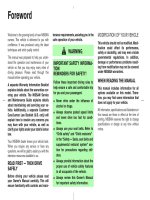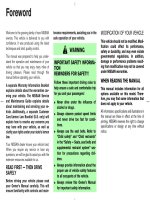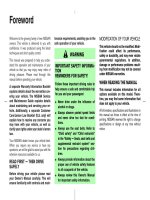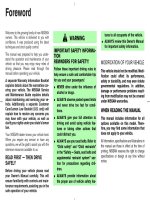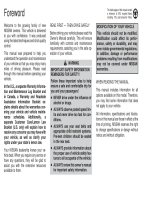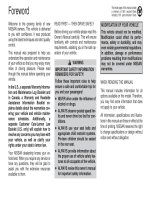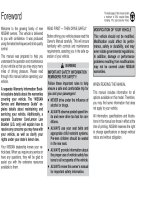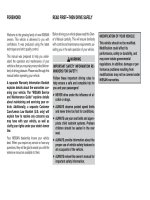Nissan Altima 2002 owner manual - Sách hướng dẫn sử dụng xe Nissan Altima đời 2002.
Bạn đang xem bản rút gọn của tài liệu. Xem và tải ngay bản đầy đủ của tài liệu tại đây (2.02 MB, 249 trang )
Foreword
Welcome to the growing family of new
NISSAN owners. This vehicle is delivered
to you with confidence. It was produced
using the latest techniques and strict quality
control.
This manual was prepared to help you
understand the operation and maintenance
of your vehicle so that you may enjoy many
miles of driving pleasure. Please read
through this manual before operating your
vehicle.
A separate Warranty Information Book-
let explains details about the warranties
covering your vehicle. The “NISSAN
Service and Maintenance Guide” ex-
plains details about maintaining and
servicing your vehicle. Additionally, a
separate Customer Care/Lemon Law
Booklet (U.S. only) will explain how to
resolve any concerns you may have with
your vehicle, as well as clarify your
rights under your state’s lemon law.
Your NISSAN dealership knows your ve-
hicle best. When you require any service or
have any questions, they will be glad to
assist you with the extensive resources
available to them.
READ FIRST — THEN DRIVE SAFELY
Before driving your vehicle please read this
Owner’s Manual carefully. This will ensure
familiarity with controls and maintenance
requirements, assisting you in the safe op-
eration of your vehicle.
WARNING
IMPORTANT SAFETY INFORMATION
REMINDERS FOR SAFETY!
Follow these important rules to help
ensure a safe and comfortable trip for
you and your passengers!
● NEVER drive under the influence of
alcohol or drugs.
● ALWAYS observe posted speed lim-
its and never drive too fast for con-
ditions.
●
ALWAYS use your seat belts and
appropriate child restraint systems.
Pre-teen children should be seated
in the rear seat.
● ALWAYS provide information about
the proper use of vehicle safety fea-
tures to all occupants of the vehicle.
●
ALWAYS review this owner’s manual
for important safety information.
MODIFICATION OF YOUR VEHICLE
This vehicle should not be modified.
Modification could affect its perfor-
mance, safety or durability, and may
even violate governmental regulations.
In addition, damage or performance
problems resulting from modifications
may not be covered under NISSAN
warranties.
WHEN READING THE MANUAL
This manual includes information for all
options available on this model. Therefore,
you may find some information that does
not apply to your vehicle.
All information, specifications and illustra-
tions in this manual are those in effect at the
time of printing. NISSAN reserves the right
to change specifications or design without
notice and without obligation.
The inside pages of this manual contain
a minimum of 50% recycled fibers,
including 10% post-consumer fibers.
੬੭
IMPORTANT INFORMATION ABOUT
THIS MANUAL
You will see various symbols in this manual.
They are used in the following ways:
WARNING
This is used to indicate the presence of
a hazard that could cause death or
serious personal injury. To avoid or
reduce the risk, the procedures must
be followed precisely.
CAUTION
This is used to indicate the presence of
a hazard that could cause minor or
moderate personal injury or damage to
your vehicle. To avoid or reduce the
risk, the procedures must be followed
carefully.
If you see this symbol, it means ‘‘Do not do
this’’ or ‘‘Do not let this happen.’’
CALIFORNIA PROPOSITION 65
WARNING
WARNING
Engine Exhaust, some of its constitu-
ents, and certain vehicle components
contain or emit chemicals known to
State of California to cause cancer and
birth defects or other reproductive
harm.
© 2002 NISSAN NORTH AMERICA, INC.
GARDENA, CALIFORNIA
All rights reserved. No part of this Owner’s
Manual may be reproduced or stored in a
retrieval system, or transmitted in any form, or
by any means, electronic, mechanical, photo-
copying, recording or otherwise, without the
prior written permission of Nissan North
America, Inc., Gardena, California.
APD1005
The inside pages of this manual contain
a minimum of 50% recycled fibers,
including 10% post-consumer fibers.
੬੭
Welcome To The World Of NISSAN
Your new NISSAN is the result of our dedication
to produce the finest in safe, reliable and eco-
nomical transportation. Your vehicle is the prod-
uct of a successful worldwide company that
manufactures cars and trucks in over 17 coun-
tries and distributes them in 170 nations.
NISSAN vehicles are designed and manufac-
tured by Nissan Motor Co., Ltd. which was
founded in Tokyo, Japan in 1933, and NISSAN
affiliates world wide, collectively growing to be-
come the fifth largest automaker in the world. In
addition to cars and trucks, NISSAN also makes
diversified forklift trucks, marine engines, boats
and other products.
NISSAN has made a substantial and growing
investment in North America. NISSAN’s commit-
ment is nearly $4 billion dollars in capital invest-
ments in facilities across the continent. Some of
the facilities include the Nissan Manufacturing
facility in Smyrna, Tennessee, vehicle styling
design at Nissan Design International in San
Diego, California, and engineering at Nissan
Technical Center North America in Farmington
Hills, Michigan. Additionally, NISSAN employs
nearly 18,000 people throughout the United
States, Canada, and Mexico. An additional
71,000 people work for the 1,500 NISSAN and
INFINITI dealers across North America.
NISSAN is also a substantial contributor to the
Canadian economy. Nissan Canada Inc., its sup-
pliers and over 140 dealers employ approxi-
mately 4,500 people. These include company
employees and the staffs of NISSAN dealers all
across Canada. In addition, many Canadians
work for companies that supply NISSAN and
NISSAN dealers with materials and services
ranging from the operation of port facilities and
transportation services, to the supply of lubri-
cants, parts and accessories.
NISSAN pioneered the use of electronics and
computers in automobiles, and has led the indus-
try in improving both performance and fuel effi-
ciency through new engine designs and the use
of synthetic materials to reduce vehicle weight.
The company has also developed ways to build
quality into its vehicles at each stage of the
production process, both through extensive use
of automation and — most importantly —
through an awareness that people are the cen-
tral element in quality control.
From the time the parts arrived from our suppli-
ers until you took delivery of your new NISSAN,
dozens of checks were made to ensure that only
the best job was being done in producing and
delivering your vehicle. NISSAN also takes great
care to ensure that when you take your NISSAN
to yourdealerfor maintenance,the service techni-
cian will perform his work according to the quality
standards that have been established by Nissan.
Safety has also been built into your NISSAN. As
you know, seat belts are an integral part of the
safety systems that will help protect you and your
passengers in the event of a sudden stop or an
accident. We urge you to use the seat belts every
time you drive the vehicle.
The NISSAN story of growth and achievement
reflects our major goal: to provide you, our
customer, with a vehicle that is built with quality
and craftsmanship — a product that we can be
proud to build and you can be proud to own.
WFW0002
੬੭
NISSAN CUSTOMER CARE PROGRAM
NISSAN CARES
Both NISSAN and your NISSAN dealer are dedicated to serving all your automotive needs. Your satisfaction with your vehicle and your
NISSAN dealer are our primary concerns. Your NISSAN dealer is always available to assist you with all your automobile sales and service
needs.
However, if there is something that your
NISSAN dealer cannot assist you with or
you would like to provide NISSAN directly
with comments or questions, please con-
tact the NISSAN Consumer Affairs Depart-
ment using our toll-free number:
For U.S. mainland and Alaska
customers
1-800-NISSAN-1
(1-800-647-7261)
For Hawaii customers
(808) 836-0888 (Oahu Number)
For CANADIAN customers
1-800-387-0122
The Consumer Affairs Department will ask
for the following information:
— Your name, address, and telephone
number
— Vehicle identification number (on dash-
board)
— Date of purchase
— Current odometer reading
— Your NISSAN dealer’s name
— Your comments or questions
OR
You can write to NISSAN with the informa-
tion on the left at:
For U.S. mainland and Alaska customers
Nissan North America Inc.
Consumer Affairs Department
P.O. Box 191
Gardena, California 90248-0191
For Hawaii customers
Nissan Motor Corporation in Hawaii
2880 Kilihau St.
Honolulu, Hawaii 96819
For Canadian customers
Nissan Canada Inc.
5290 Orbitor Drive
Mississauga, Ontario L4W 4Z5
We appreciate your interest in NISSAN and thank you for buying a quality NISSAN vehicle.
੬੭
੬੭
Table of
Contents
Seats, restraints and supplemental air bag systems
Instruments and controls
Pre-driving checks and adjustments
Heater, air conditioner and audio systems
Starting and driving
In case of emergency
Appearance and care
Maintenance and do-it-yourself
Technical and consumer information
Index
1
2
3
4
5
6
7
8
9
10
੬੭
1 Seats, restraints and supplemental air
bag systems
Seats 1-2
Front manual seat adjustment 1-3
Front power seat adjustment (driver’s
seat) (if so equipped) 1-4
Folding rear seat 1-6
Head restraint adjustment 1-7
Supplemental restraint system 1-8
Precautions on supplemental restraint
system 1-8
Supplemental air bag warning labels 1-19
Supplemental air bag warning light 1-19
Seat belts 1-21
Precautions on seat belt usage 1-21
Child safety 1-23
Pregnant women 1-24
Injured persons 1-24
Three-point type seat belt with retractor 1-24
Seat belt extenders 1-28
Seat belt maintenance 1-28
Child restraints 1-28
Precautions on child restraints 1-28
Installation on rear seat center or
outboard positions 1-30
LATCH (Lower anchors and tether for
children) system 1-35
Top tether strap child restraint 1-37
Installation on front passenger seat 1-38
੬੭
WARNING
● Do not ride in a moving vehicle when
the seatback is reclined. This can be
dangerous. The shoulder belt will
not be against your body. In an acci-
dent you could be thrown into it and
receive neck or other serious inju-
ries. You could also slide under the
lap belt and receive serious internal
injuries.
● For most effective protection when
the vehicle is in motion, the seat
should be upright. Always sit well
back in the seat and adjust the seat
properly. See ‘‘Precautions on Seat
Belt Usage’’ later in this section.
ARS1131
SEATS
1-2 Seats, restraints and supplemental air bag systems
੬੭
FRONT MANUAL SEAT
ADJUSTMENT
WARNING
● Do not adjust the driver’s seat while
driving so full attention may be given
to vehicle operation. The seat may
move suddenly and could cause
loss of control of the vehicle.
● After adjustment, gently rock in the
seat to make sure it is securely
locked.
Forward and backward
Pull the lever up while you slide the seat
forward or backward to the desired position.
Release the lever to lock the seat in posi-
tion.
Reclining
To recline the seatback, pull the lever up
and lean back. To bring the seatback for-
ward again, pull the lever and move your-
body forward.
WRS0001
Seats, restraints and supplemental air bag systems 1-3
੬੭
Seat lifter (Driver’s seat) (if so
equipped)
Turn either dial to adjust the angle and
height of the seat cushion to the desired
position.
FRONT POWER SEAT
ADJUSTMENT (Driver’s seat) (if
so equipped)
WARNING
● Do not adjust the driver’s seat while
driving so full attention may be given
to vehicle operation. The seat may
move suddenly and could cause
loss of control of the vehicle.
● Do not leave children unattended in-
side the vehicle. They could un-
knowingly activate switches or con-
trols. Unattended children could
become involved in serious acci-
dents.
Operating Tips
● The motor has an auto-reset overload
protection circuit. If the motor stops dur-
ing operation, wait 30 seconds, then re-
activate the switch.
SPA0099A LRS0016
1-4 Seats, restraints and supplemental air bag systems
੬੭
● Do not operate the power seat switch for
a long period of time when the engine is
off. This will discharge the battery.
Forward and backward
Moving the switch forward or backward will
slide the seat forward or backward to the
desired position.
Reclining
Move the recline switch backward until the
desired angle is obtained. To bring the
seatback forward again, move the switch
forward and move your body forward. The
seatback will move forward.
Seat lifter (if so equipped for driver’s
seat)
Push the front or rear end of the switch up or
down to adjust the angle and height of the
seat cushion.
Lumbar support (if so equipped for
driver’s seat)
The lumbar support feature provides lower
back support to the driver. Move the lever
up or down to adjust the seat lumbar area.
LRS0017 ARS1035
Seats, restraints and supplemental air bag systems 1-5
੬੭
FOLDING REAR SEAT
Interior trunk access
The trunk can be accessed from the pas-
senger side of the rear seat for loading and
unloading, as shown.
To fold down the driver side of the rear seat,
reach through the opening and pull on the
strap located behind the seat.
The rear seats can be locked using the
master key to prevent unauthorized access.
The valet key cannot be used to lock or
unlock the release button.
WARNING
● Never allow anyone to ride in the
luggage area or on the rear seat
when it is in the fold-down position.
Use of these areas by passengers
without proper restraints could re-
sult in serious injury in an accident
or sudden stop.
● Properly secure all cargo to help
prevent it from sliding or shifting. Do
not place cargo higher than the seat-
backs. In a sudden stop or collision,
unsecured cargo could cause per-
sonal injury.
● When returning seatbacks to the up-
right position, be certain they are
completely secured in the latched
position. If they are not completely
secured in the latched position, pas-
sengers may be injured in an acci-
dent or sudden stop.
● Closely supervise children when
they are around cars to prevent them
from playing and becoming locked
in the trunk where they could be
seriously injured. Keep the car
locked, with the rear seat back se-
curely latched, when not in use, and
prevent children’s access to car
keys.
LRS0102
1-6 Seats, restraints and supplemental air bag systems
੬੭
Center armrest
Pull the armrest forward until it is horizontal.
HEAD RESTRAINT ADJUSTMENT
To raise the head restraint, pull it up. To
lower, push and hold the lock knob and
push the head restraint down.
WARNING
Head restraints should be adjusted
properly as they may provide signifi-
cant protection against injury in an ac-
cident. Do not remove them. Check the
adjustment after someone else uses
the seat.
Adjust the head restraints so the center is
level with the center of your ears.
LRS0103 PD1319 WRS0096
Seats, restraints and supplemental air bag systems 1-7
੬੭
PRECAUTIONS ON SUPPLE-
MENTAL RESTRAINT SYSTEM
This Supplemental Restraint System (SRS)
section contains important information con-
cerning the driver and passenger front im-
pact supplemental air bags, front seat side-
impact supplemental air bags, curtain air
bags and front seat pre-tensioner seat belts.
Front impact supplemental air bag sys-
tem: This system can help cushion the
impact force to the face and chest of the
driver and front passenger in certain frontal
collisions.
Side-impact supplemental air bag sys-
tem: This system can help cushion the
impact force to the chest area of the driver
and front passenger in certain side impact
collisions. The front seat side-impact
supplemental air bags are designed to in-
flate on the side where the vehicle is im-
pacted.
Side impact supplemental curtain air bag
system: This system can help cushion the
impact force to the head of occupants in
front and rear outboard seating positions in
certain side impact collisions. The curtain
air bags are designed to inflate on the side
where the vehicle is impacted.
These supplemental restraint systems are
designed to supplement the crash protec-
tion provided by the driver and front passen-
ger seat belts and are not a substitute for
them. Seat belts should always be correctly
worn and the occupant seated a suitable
distance away from the steering wheel, in-
strument panel and door finishers. (See
‘‘Seat belts’’ later in this section for instruc-
tions and precautions on seat belt usage.)
After turning the ignition key to the ON
position, the supplemental air bag warn-
ing light illuminates. The supplemental
air bag warning light will turn off after
about 7 seconds if the systems are op-
erational.
SUPPLEMENTAL RESTRAINT
SYSTEM
1-8 Seats, restraints and supplemental air bag systems
੬੭
WARNING
● The supplemental front air bags or-
dinarily will not inflate in the event of
a side impact, rear impact, roll over,
or lower severity frontal collision.
Always wear your seat belts to help
reduce the risk or severity of injury
in various kinds of accidents.
●
The seat belts and the supplemental
front air bags are most effective when
you are sitting well back and upright
in the seat. Front air bags inflate
with great force. If you are unre-
strained, leaning forward, sitting side-
ways or out of position in any way,
you are at greater risk of injury or
death in a crash. You may also re-
ceive serious or fatal injuries from the
supplemental front air bag if you are
up against it when it inflates. Always
sit back against the seatback and as
far away as practical from the steering
wheel or instrument panel. Always
use the seat belts.
● The driver and front passenger seat
belt buckles are equipped with sen-
sors that detect if the seat belts are
fastened. The air bag system monitors
the severity of a collision and then
inflates the air bags based on belt
usage. Failure to properly wear seat
belts can increase the risk or severity
of injury in an accident.
● Keep hands on the outside of the
steering wheel. Placing them inside
the steering wheel rim could increase
the risk that they are injured when the
supplemental front air bag inflates.
ARS1132
Seats, restraints and supplemental air bag systems 1-9
੬੭
ARS1133 ARS1041
ARS1042
1-10 Seats, restraints and supplemental air bag systems
੬੭
WARNING
● Never let children ride unrestrained
or extend their hands or face out of
the window. Do not attempt to hold
them in your lap or arms. Some ex-
amples of dangerous riding posi-
tions are shown in the previous illus-
trations.
● Children may be severely injured or
killed when the supplemental front
air bag or supplemental side air bag
inflates if they are not properly re-
strained.
● Also, never install a rear facing child
restraint in the front seat. An inflat-
ing supplemental front air bag could
seriously injure or kill your child.
See ‘‘Child restraints’’ later in this
section for details.
ARS1043
ARS1044
ARS1045
ARS1046
Seats, restraints and supplemental air bag systems 1-11
੬੭
WARNING
Supplemental side air bag and curtain
air bag:
● The supplemental side air bag and
curtain air bag ordinarily will not
inflate in the event of a frontal im-
pact, rear impact, rollover or lower
severity side collision. Always wear
your seat belts to help reduce the
risk or severity of injury in various
kinds of accidents.
● The seat belts and the supplemental
side air bags and curtain air bags are
most effective when you are sitting
well back and upright in the seat.
The side air bag and curtain air bag
inflate with great force. Do not allow
anyone to place their hand, leg or
face near the side air bag on the side
of the seatback of the front seat or
near the side roof rails. Do not allow
anyone sitting in the front seats or
rear outboard seats to extend their
hand out of the window or lean
against the door. Some examples of
dangerous riding positions are
shown in the previous illustrations.
When sitting in the rear seat, do not
hold onto the seatback of the front
seat. If the supplemental side air bag
inflates, you may be seriously in-
jured. Be especially careful with chil-
dren, who should always be properly
restrained.
● Do not use seat covers on the front
seatbacks. They may interfere with
supplemental side air bag inflation.
SSS0101 SSS0140
1-12 Seats, restraints and supplemental air bag systems
੬੭
SSS0159 SSS0162
Seats, restraints and supplemental air bag systems 1-13
੬੭
Supplemental front air bag system
The driver supplemental air bag is located in
the center of the steering wheel; the front
passenger supplemental air bag is mounted in
the dashboard above the glove box. These
systems are designed to meet optional certi-
fication requirements under U.S. regulations.
They are also permitted in Canada. The op-
tional certification allows front air bags to be
designed to inflate somewhat less forcefully
than previously. However, all of the informa-
tion, cautions and warnings in this manual
still apply and must be followed. The front
air bags are designed to inflate in higher
severity frontal collisions, although they may
inflate if the forces in another type of collision
are similar to those of a higher severity frontal
impact. They may not inflate in certain frontal
collisions. Vehicle damage (or lack of it) is not
always an indication of proper supplemental
air bag operation.
The supplemental air bag system has dual
stage inflators for both the driver and pas-
senger air bags. The system monitors infor-
mation from the crash zone sensor, the
diagnosis sensor unit and seat belt buckle
sensors that detect if the seat belts are
fastened. Inflator operation is based on the
severity of a collision and whether the seat
belts are being used.
When the supplemental front air bag in-
flates, a fairly loud noise may be heard,
followed by release of smoke. This smoke is
not harmful and does not indicate a fire.
Care should be taken not to inhale it, as it
may cause irritation and choking. Those
with a history of a breathing condition
should get fresh air promptly.
Supplemental front air bags, along with the
LRS0104
1-14 Seats, restraints and supplemental air bag systems
੬੭
use of seat belts, help to cushion the impact
force on the face and chest of the front
occupants. They can help save lives and
reduce serious injuries. However, an inflat-
ing front air bag may cause facial abrasions
or other injuries. Front air bags do not
provide restraint to the lower body.
The seat belts should be correctly worn and
the driver and passenger seated upright as
far as practical away from the steering
wheel or dash board. The supplemental
front air bags inflate quickly in order to help
protect the front occupants. Because of this,
the force of the front air bag inflating can
increase the risk of injury if the occupant is
too close to or is against the air bag module
during inflation.The air bag will deflate
quickly after the collision is over.
After turning the ignition key to the ON
position, the supplemental air bag warn-
ing light illuminates. The air bag warning
light will turn off after about 7 seconds if
the system is operational.
WARNING
●
Do not place any objects on the steer-
ing wheel pad or on the instrument
panel. Also, do not place any objects
between any occupant and the steer-
ing wheel or instrument panel. Such
objects may become dangerous pro-
jectiles and cause injury if the supple-
mental front air bag inflates.
● Right after inflation, several air bag
system components will be hot. Do
not touch them; you may severely
burn yourself.
●
No unauthorized changes should be
made to any components or wiring of
the supplemental front air bag sys-
tem. This is to prevent accidental in-
flation of the air bag or damage to the
air bag system.
● Do not make unauthorized changes
to your vehicle’s electrical system,
suspension system or front end
structure. This could affect proper
operation of the supplemental front
air bag system.
●
Tampering with the supplemental front
air bag system may result in serious
personal injury. For example, do not
change the steering wheel and the in-
strument panel assembly by placing
material over the steering wheel pad
and above the instrument panel, or by
installing additional trim material
around the air bag system.
●
Work around and on the supplemental
front air bag system should be done
by an authorized NISSAN retailer. In-
stallation of electrical equipment
should also be done by an authorized
NISSAN retailer. The yellow and or-
ange Supplemental Restrain System
(SRS) wiring and connectors should
not be modified or disconnected. Un-
authorized electrical test equipment
and probing devices should not be
used on the air bag system.
● A cracked windshield should be re-
placed immediately by a qualified
repair facility. A cracked windshield
could affect inflation of the supple-
mental air bag system.
●
The SRS wiring harness connectors are
yellow and orange for easy identification.
When selling your vehicle, we request that
you inform the buyer about the supple-
mental front air bag system and guide the
buyer to the appropriate sections in this
Owner’s Manual.
Seats, restraints and supplemental air bag systems
1-15
੬੭
Supplemental side air bag and cur-
tain air bag system (if so equipped)
The supplemental side air bags are located
in the outside of the seatback of the front
seats. The supplemental curtain air bags
are located in the roof side rails. These
systems are designed to meet voluntary
guidelines to help reduce the risk of injury to
out-of-position occupants. However, all of
the information, cautions and warnings
in this manual still apply and must be
followed. The supplemental side air bags
and curtain air bags are designed to inflate
in higher severity side collisions, although
they may inflate if the forces in another type
of collision are similar to those of a higher
severity side impact. They are designed to
inflate on the side where the vehicle is
impacted. They may not inflate in certain
side collisions. Vehicle damage (or lack of
it) is not always an indication of proper
supplemental side air bag operation.
When the supplemental side air bag and
curtain air bag inflate, a fairly loud noise
may be heard, followed by release of
smoke. This smoke is not harmful and does
not indicate a fire. Care should be taken not
to inhale it, as it may cause irritation and
choking. Those with a history of a breathing
condition should get fresh air promptly.
Supplemental side air bags, along with the
use of seat belts, help to cushion the impact
force on the chest of the front occupants.
Curtain air bags help to cushion the impact
force to the head of occupants in the front
and rear outboard seating positions. They
can help save lives and reduce serious
injuries. However, an inflating side air bag
and curtain air bag may cause abrasions or
other injuries. Supplemental side air bags
and curtain air bags do not provide restraint
to the lower body.
The seat belts should be correctly worn and
the driver and passenger seated upright as
far as practical away from the side air bag.
Rear seat passengers should be seated as
far away as practical from the door finishers
and side roof rails. The side air bags and
curtain air bag inflate quickly in order to help
protect the front occupants. Because of this,
the force of the side air bag and curtain air
bag inflating can increase the risk of injury if
the occupant is too close to, or is against,
these air bag modules during inflation. The
side air bag and curtain air bag will deflate
quickly after the collision is over.
After turning the ignition key to the ON
position, the supplemental air bag warn-
ing light illuminates. The air bag warning
light will turn off after about 7 seconds if
the system is operational.
WARNING
● Do not place any objects near the
seatback of the front seats. Also, do
not place any objects (an umbrella,
bag, etc.) between the front door
finisher and the front seat. Such ob-
jects may become dangerous pro-
jectiles and cause injury if the side
air bag inflates.
LRS0105
1-16 Seats, restraints and supplemental air bag systems
੬੭
● Right after inflation, several side air
bag and curtain air bag system com-
ponents will be hot. Do not touch
them; you may severely burn your-
self.
● No unauthorized changes should be
made to any components or wiring
of this side air bag and curtain air
bag system. This is to prevent acci-
dental inflation of the side air bag
and curtain air bag or damage to the
side air bag and curtain air bag sys-
tem.
● Do not make unauthorized changes
to your vehicle’s electrical system,
suspension system or side panel.
This could affect proper operation of
the supplemental side air bag and
curtain air bag system.
● Tampering with the supplemental
system may result in serious per-
sonal injury. For example, do not
change the front seat by placing ma-
terial near the seatback or by install-
ing additional trim material, such as
seat covers, around the side air bag.
● Work around and on the side air bag
and curtain air bag system should be
done by an authorized NISSAN re-
tailer. Installation of electrical equip-
ment should also be done by an
authorized NISSAN retailer. The SRS
wiring harnesses* should not be
modified or disconnected. Unautho-
rized electrical test equipment and
probing devices should not be used
on the side air bag system.
* The SRS wiring harness connectors
are yellow and orange for easy identi-
fication.
When selling your vehicle, we request that
you inform the buyer about the side air bag
and curtain air bag system and guide the
buyer to the appropriate sections in this
Owner’s Manual.
Pre-tensioner seat belt system (For
front seats)
WARNING
● The pre-tensioner seat belt cannot
be reused after activation. It must be
replaced together with the retractor
as a unit.
● If the vehicle becomes involved in a
frontal collision but the pre-
tensioner is not activated, be sure to
have the pre-tensioner system
checked and, if necessary, replaced
by your NISSAN retailer.
● No unauthorized changes should be
made to any components or wiring
of the pre-tensioner seat belt sys-
tem. This is to prevent accidental
activation of the pre-tensioner seat
belt or damage to the pre-tensioner
seat belt operation. Tampering with
the pre-tensioner seat belt system
may result in serious personal in-
jury.
● Work around and on the pre-
tensioner system should be done by
an authorized NISSAN retailer. In-
stallation of electrical equipment
should also be done by an autho-
rized NISSAN retailer. Unauthorized
electrical test equipment and prob-
ing devices should not be used on
Seats, restraints and supplemental air bag systems
1-17
੬੭
the pre-tensioner seat belt system.
● If you need to dispose of the pre-
tensioner or scrap the vehicle, con-
tact an authorized NISSAN retailer.
Correct pre-tensioner disposal pro-
cedures are set forth in the appropri-
ate NISSAN Service Manual. Incor-
rect disposal procedures could
cause personal injury.
The front seat pre-tensioner seat belt sys-
tem activates in conjunction with the supple-
mental front air bag. Working with the seat
belt retractor, it helps tighten the seat belt
the instant the vehicle becomes involved in
certain types of collisions, thereby restrain-
ing seat occupants.
The pre-tensioner is encased with the seat
belt’s retractor. These seat belts are used
the same as conventional seat belts.
When the pre-tensioner seat belt activates,
smoke is released and a loud noise may be
heard. The smoke is not harmful, but care
should be taken not to inhale it as it may
cause irritation and choking. Those with a
history of a breathing condition should get
fresh air promptly.
If any abnormality occurs in the pre-
tensioner system, the supplemental air bag
warning light
will not come on, will
flash intermittently or will turn on for 7
seconds and remain on after the ignition key
has been turned to the ON or START posi-
tion. In this case, the pre-tensioner seat belt
may not function properly. They must be
checked and repaired. Take your vehicle to
the nearest authorized NISSAN Retailer.
When selling your vehicle, we request that
you inform the buyer about the pre-
tensioner seat belt system and guide the
buyer to the appropriate sections in this
Owner’s Manual.
1-18 Seats, restraints and supplemental air bag systems
੬੭

